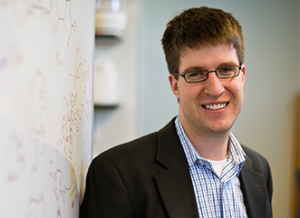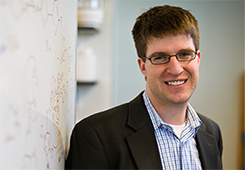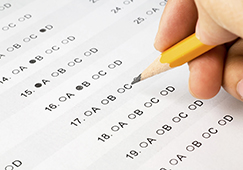Inclusive Excellence in STEM Teaching: Samuel Thomas
Samuel Thomas, Associate Professor in the Department of Chemistry, shares insights on Inclusive Excellence in STEM teaching, assessing student learning, and his experience with flipped classroom models.

Department/School: Chemistry (Arts and Sciences)
Course: Organic Chemistry
Students: 2nd-4th year
Inclusive Excellence in STEM Teaching
You recently explored the idea of Inclusive Excellence with a few colleagues teaching in the STEM field. What is your big “take-away”?
As a community, in terms of people from under-represented backgrounds and first generation students, I feel that we should focus on improving the retention of students in STEM. How do we keep the same amount of rigor, while providing support to students from less traditional backgrounds?
I’m trying to focus more on student understanding, rather than on just performance on individual exams performance. This last semester, after exams were returned to the students, they were allowed to make up partial credit on wrong answers. With this incentive, students used the opportunity to learn – very helpful for those who experience stress during exams. The students definitely liked this – there was very high participation. Part of me was concerned that this might decrease the rigor of the course, but I decided that it’s more about promoting student understanding.
Teaching Innovations
You have attempted to make your Organic Chemistry course more accessible to your students by “flipping” some parts of your course. What was your goal and what have you done so far (i.e., specific tools/methods you used)?
My lectures are largely in a traditional format, but with frequent student engagement and think/pair/share exercises. The recitation sessions follow a peer-led team-learning model to encourage students to communicate and work together on more challenging problems. Also, I poll the students (with Trunk’s polling feature), and have done mid-semester surveys (with Qualtrics). Using this feedback (along with quiz results) to determine problem areas, I record supplemental screencast videos to address concepts the students find confusing. The students seem to appreciate this.
Lessons Learned: Connecting Dots
Reflecting on the two experiences you described above, all attempting to be a better reflective teacher, what are some lessons learned you would like to share with your peers? What are some remaining challenges?
The most important lesson that I have learned is to try to focus on an appropriate balance of what I want students to learn and remember after the course is over with the necessity of covering a certain amount of material. It is balance that I am always striving to improve, so it remains a significant challenge.
Reflection & Next Steps
What kind of impact has your effort made on student learning, either through your observation or a kind of measure? What do you hope to do next?
So far, students seem to like what I’ve done, but that’s an individual effort with very little data – we need more data. I would be thrilled to partner with an on-campus resource for faculty, such as CELT, in order to assess these and other approaches, and their impact on inclusive excellence in the introductory STEM courses.
Although there is a lot of analysis to do, at least I know for now that the students like these approaches, and liking the class is an important part of retention.




